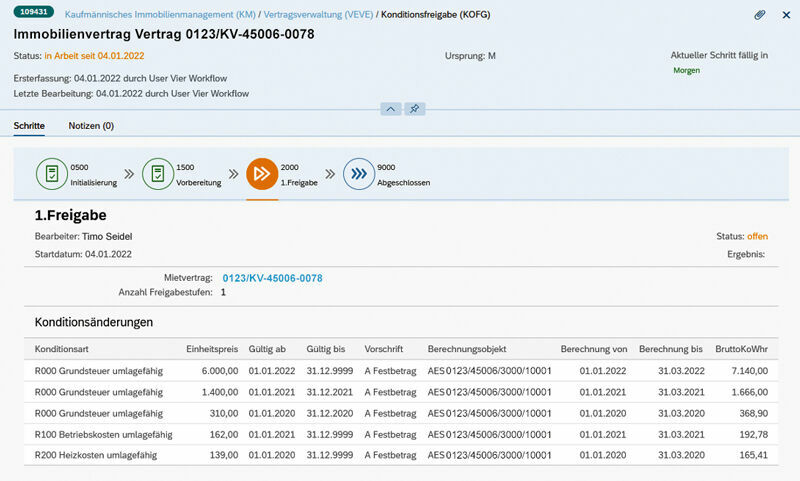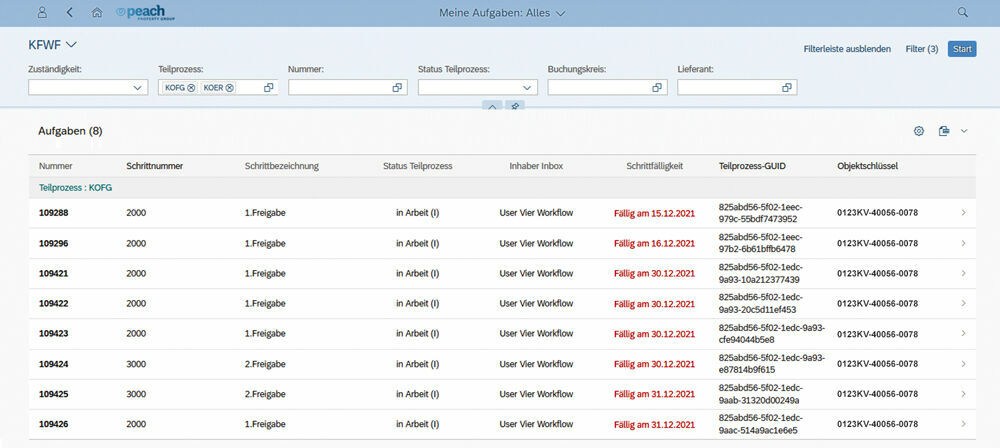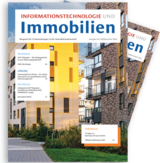Maximising security and transparency with the easysquare condition change release workflow at Peach Property

As a company stakeholder, you are undoubtedly aware of the large responsibility borne by companies for employees in relation to the movement of large or even small sums of money. Addressing this responsibility means investing a lot of effort in monitoring and controlling financial transactions. Even then, human error cannot be completely ruled out. Mistakes can unfortunately still occur from time to time. As a major real estate investor, Peach Property Group takes its responsibilities seriously. The company proactively sought a solution that would allow it to make these processes time-saving and efficient, while also holding all parties involved accountable for ensuring that the processes take place in an entirely secure and controlled manner. Since PROMOS had long been developing just such a solution, cooperation between the two companies came about at just the right time.
Peach Property Group
Peach Property Group is a tenant-focused, rapidly growing company that invests primarily in residential properties in medium-sized cities in Germany. With its focus on metropolitan areas and a tenant-friendly business model, the company is a pioneer in its field. It owns roughly 27,500 residential units.[1] Recognising that digitisation and automation are important building blocks in its target-driven growth, it already found the ideal partner in PROMOS in 2019 to complete the digital transformation of other important company processes following the introduction of S/4HANA®.
Timo Seidel, SAP Project Manager at Peach Property Group
Added security
Peach Property Group owns a portfolio of properties and is listed on the stock exchange. The security of all transactions and transparency in relation to investors therefore has the highest priority. Thanks to the easysquare condition change release workflow, the company can structure contractual financial transactions in a transparent and secure manner. With this workflow, changes can no longer be easily triggered by a single individual. In the current job market, this clearly stands out as an important benefit: not many companies can present their transactions so securely and openly. A change usually goes through several authentications depending on the amount of the condition total (Figure 1). Major condition changes must be approved by members of the management board. The size is determined automatically, saving time spent on the task. There are a total of three release levels to potentially go through. Depending on the size of the change, the condition release workflow contains either one, two or three release levels.

Figure 1: First release level of a condition change: The first version is documented in the header area. The processor of a change and the releaser must not be the same person.
The PROMOS development team has also incorporated another security feature: the processes cannot be terminated arbitrarily. All changes made must be manually undone in the contract. A reason for terminating a process must always be registered in order to maintain maximum transparency. The master data lock also ensures additional security. It is automatically activated when a release process is active. In practical terms, this means that a contract can only be changed from within the actual process and only by certain employees.
Added automation
In addition to providing increased security, the condition change release workflow’s high level of automation enables faster workflows: “First, from a company perspective, the workflows save us costs that would otherwise be incurred for a higher workload. Second, they save our employees time which they can now invest elsewhere in more complex tasks,” says Timo Seidel, SAP project manager at Peach Property Group. If the change in the condition total exceeds a certain minimum value, the relevant release instances are automatically notified. In this case, the change can only take place with their release. An interface enables transactions to be processed quickly, even with external stakeholders. For example, if a scanning service provider submits a certain amount of money to SAP®, the change is immediately forwarded to Peach Property Group. The company can then approve or reject it in the case of a large sum. Essentially, a lot of unnecessary paperwork is eliminated for the company and changes can be processed at lightning speed. In theory, employees no longer even have to seek out a contract to initiate or release a change.

Figure 2: All user-specific process instances in the Fiori® launchpad that need to be processed are displayed under “My tasks”.
Once employees make changes to contract conditions, this often results in a change to the gross amount in cash flow. Thanks to the automated workflows, a release process is automatically started in such cases. “The time available to our employees and management board is precious and, of course, limited. That’s why we don’t want to be notified of every minuscule change,” explains Timo Seidel from Peach Property Group.
Even more added clarity and control
Of course, changes can also be initiated manually so that they trigger the start of manual condition release workflows. For example, if an employee inserts a change in the contract, a new condition is created. Condition changes can also be rejected, although a reason for rejection is always required. In this way, Peach Property Group always retains control over the workflows despite the high level of automation. The process list gives employees an organised overview of all processes. Employees can filter these processes to provide an even clearer overview. In the “My Tasks” app (Figure 2), employees working on a particular process step can immediately call up all the important information they need.
Outlook
As well as being a very pleasant experience for all involved, the Peach Property Group project was also a complete success. Everyone agreed that it was an important building block in the company’s digital transformation. Digitised and automated workflows for financial contracts in the real estate industry have clearly proven to be not just important, but essential for security and transparency in relation to corporate partners and investors. The condition change release workflow is therefore only the beginning. Work is now underway on a contract activation release workflow. While this may sound complicated, in principle it is simply a concept for releasing contract activations. In practical terms, this means that this new solution creates a second level of contract security and transparency, thus making the creation and activation of contracts easier and more secure.
As a reader of IT&I Magazine, you’ll be kept up to date about the most recent and innovative solutions for conditions and contracts. Stay tuned!
- December 2021 https://www.peachproperty.com/en/portfolio-en/
Author:

Tamara Erdenberger
Professional Consultant Real Estate
PROMOS consult
Other articles by this author:


